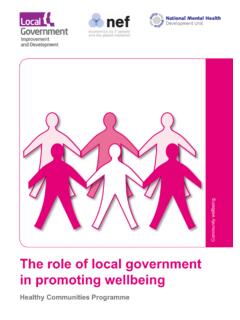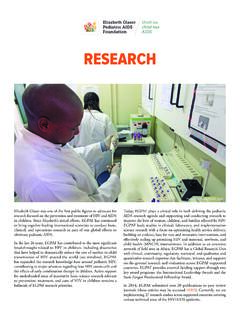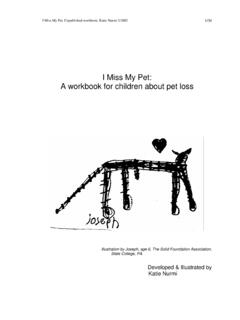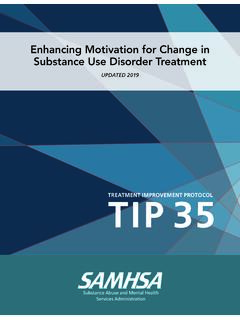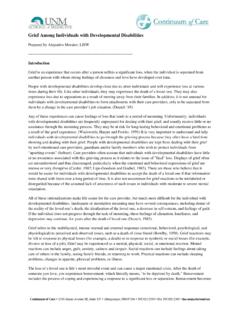Transcription of The Impact of Homicide on Families of Murder Victims
1 RACHEL S FUND, a program of the National Coalition to Abolish the Death Penalty 1705 DeSales Street, NW, Fifth Floor, Washington, DC 20036 202-331-4090 Fax 202-331-4099 The Impact of Homicide on Families of Murder Victims September, 2010 Introduction The following information is provided for the purpose of grounding NCADP Affiliates volunteers, staff and leadership in a deeper understanding of the experience of Families of Murder Victims . A significant portion of this information is background material on the crisis and trauma associated with the experience of Homicide . It is provided so that you have a framework for understanding the challenges that arise for Victims in their journey to construct a new life. This material is general in that it does not take into consideration issues of ethnicity, race, religion and others aspects of our multicultural America, all of which influence our trauma response. The themes, however, are applicable across the board.
2 Throughout this document the phrases Families of Murder Victims , survivors and Victims are used interchangeably. This is common language in the victim services field. What is most important is to use the language of the individual survivor. Trauma - The Crisis Response As with most Victims of violent crime, the usual response to a Homicide is crisis. The death notification process will elicit a crisis response in Families of Murder Victims , and a crisis response has both an emotional and physical response. Understanding this initial crisis response is important in comprehending the experience of Families of Murder Victims both in the immediate aftermath and long term during the construction of their new life. The Physical Response The body s first response to trauma is to attempt to physically protect itself from the trauma. The body may go into a hyper state of alertness, ridding itself of excess and getting ready for a fight or flight.
3 Families of Murder Victims are traumatized by the death notification itself. Family members of Murder Victims often report: Physical shock Numbness Disorientation Increased adrenaline, heart palpitations, nausea, vomiting, sweating and hyperventilation Hyper alertness (exaggerated responses) Panic attacks difficult breathing, tightness of chest Constant crying or the inability to cry The Emotional Response The emotional response can include anger or rage, fear or terror, frustration and confusion, guilt and self-blame, shame and humiliation, and grief or sorrow. Any and all of these emotions may be present. As a response, the brain becomes overwhelmed and disorganized and experiences the The Impact of Homicide on Families of Murder Victims ~ September, 2010 Page 2 1705 DeSales Street, NW, Fifth Floor, Washington, DC 20036 202-331-4090 Fax 202-331-4099 trauma as a threat and responds with fear and anger.
4 As a result of the threat, the brain sends an emergency all systems go signal, which bypasses the cognitive part of the brain. Normally the emotional and cognitive parts of the brain are more in balance. The cognitive part of the brain can only function when the emotional turmoil in the brain subsides. Since the cognitive part of the brain is disengaged during the trauma, our ability to process, build our story through organization and utilize cognitive analysis is impaired. That is why over time the story that is told is more elaborate, more detailed, etc. Families of Murder Victims report: Recurrent nightmares about the actual Murder (whether they know what happened or not) Rage toward the person responsible Anger toward the victim for being in the wrong place at the wrong time Depression and helplessness/powerlessness Hatred toward God Loneliness and isolation grief Worden (1991) described four tasks of grieving.
5 These included: accepting the reality of the loss; feeling the grief ; adjusting to a life in which the deceased is no longer present; and emotionally relocating the deceased so that life can go The first task (Worden, 1991) is to acknowledge and accept the reality of the loss that the loved one is dead. Survivors often report a sense that their loved one will come up the driveway as usual at the end of the workday. Others have reported that they felt impelled to follow someone who looked just like their deceased loved one. It is often difficult for Homicide survivors who have not had a chance to see their loved one s body to know, finally, that it was not some terrible mistake and that their loved one is really dead. The second task identified by Worden (1991) is that mourners must acknowledge and experience the pain associated with losing their loved ones, whether it is physical and/or emotional pain. This is one of the most difficult tasks a mourner faces, even under the most supportive of circumstances.
6 Homicide survivors often find that they must put their feelings on hold as they follow court hearings, trials and numerous appeals. However, no matter how the pain of the loss is held back or put aside, Worden states that the mourners must experience these feelings or they may carry the pain of the loss for the rest of their lives. The third task described by Worden (1991) is to adjust to a life in which the loved one is no longer present. At this point, family members begin to make personal or lifestyle changes with might take them in a very different direction than they planned while their loved one was still alive. Often family members may feel some guilt around these new decisions, wondering 1 Office of Victims for Crime, United States Department of Justice, 2009 National Victim Assistance Academy Participants Manual Chapter 11 Homicide , 2009. The Impact of Homicide on Families of Murder Victims ~ September, 2010 Page 3 1705 DeSales Street, NW, Fifth Floor, Washington, DC 20036 202-331-4090 Fax 202-331-4099 whether they are being disloyal to their relationship with the deceased.
7 It is important for survivors to recognize and come to terms with these reactions and feelings. The last task Worden described (1991) is that the mourner must somehow find a place for their loved one within their emotional life that can, at the same time, permit them to go on in the world. Survivors will not forget their loved one, but eventually they will realize that their lives can and do go Uniqueness of grief There are several factors that separate the reactions of Families of Murder Victims from those whose loved ones did not die violently. Deborah Spungen, a clinical social worker and mother of a murdered child, states in her book, Homicide : The Hidden Victims , that much of what we know about the experiences of others in the grief and bereavement process can be generalized to the experience of Families of Murder Victims . However, the complexities of Homicide are such that its sudden nature, the intensity of the survivor s reactions and the death at the hands of another make this grief different.
8 Spungen states: In the aftermath of a Homicide , the co- Victims are often involved in various activities imposed on them by the medical examiner, the criminal justice system, and possibly the media. This is true whether or not an arrest is made. Such involvement is not by choice, and these endeavors are time consuming, physically and emotionally exhausting, and sometimes quite public. Co- Victims are left with little energy to traverse the rest of the grief process, which is distinct from the experience by those whose loved one did not die violently. As a result, co- Victims may be incapable of moving on to other phases until there is some finality to the legal aspects of the case, such as the completion of the trial. Traumatic grief In her book, Spungen utilizes the term Traumatic grief . Traumatic grief can most simply be stated as an integration of trauma throughout the mourning process. It is a combination of trauma reactions and grief reactions.
9 The complexities of Homicide as stated above distinguish the experience of Families of Murder Victims from other forms of grief . Traumatic grief takes into account the unique experience of Families of Murder Victims , which adds stressors to the already complicated grief process. Spungen believes that this term more accurately describes the common reactions of Families of Murder Victims . Experience of Families of Murder Victims The complexities of Homicide serve as a distraction from the actual grief work that survivors must do in order to reconstruct their lives. Whether it is the intrusiveness of the justice system, the continual involvement of the media or the death notification process itself, these elements may require participation from the surviving family members and they almost always cause additional stress and trauma. These elements (the Homicide differentials) are intrusive to the 2 Office for Victims of Crime, Department of Justice 2002.
10 National Victim Assistance Academy Participants Manual Chapter 18 The Impact of Homicide on Families of Murder Victims ~ September, 2010 Page 4 1705 DeSales Street, NW, Fifth Floor, Washington, DC 20036 202-331-4090 Fax 202-331-4099 recovery process. They distract individuals in ways that keep them away from the important work of dealing with the trauma, grief and overall reconstruction of their Death Notification Process An ill-conceived and poorly delivered death notification predisposes the co-victim to later complications in the area of trauma and grief . Whatever co- Victims remember, or do not remember, about the ensuing days immediately after the Murder , they can usually recall most of the details of the death notification. They may not remember every word, but the essence of the words and the manner in which they were delivered will stay with them forever. The death notification becomes intertwined with the trauma of the event and resurfaces with the other traumatic memories of the The Justice System If one set out by design to devise a system for provoking intrusive post traumatic symptoms, one could not do better than a court of law.

